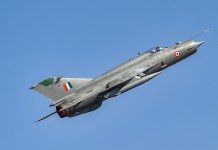Egypt is all set to acquire the National Advanced Surface-to-Air Missile System (NASAMS)—the American air defense system that protects Capitol Hill in Washington, D.C, and is also deployed in war-torn Ukraine. The acquisition is in line with its policy of modernising its military by diversifying arms purchases.
The Pentagon has announced that the US State Department has authorized the possible sale of a $4.67 billion surface-to-air missile package to the Egyptian government.
The Defense Security Cooperation Agency announced on July 24 that it has approved a “possible Foreign Military Sale” of a package of National Advanced Surface-to-Air Missile Systems (NASAMS), which includes hundreds of missiles, dozens of guidance units, and four AN/MPQ-64 Sentinel radar systems.
“This proposed sale will support the foreign policy goals and national security objectives of the United States by improving the security of a major non-NATO ally that is a force for political stability and economic progress in the Middle East,” the Defense Security Cooperation Agency statement said.
However, the deal needs to be approved by Congress, which has already been notified by the Defense Agency. If the sale is authorized by Congress, approximately 34 contractors and 26 US government workers will spend an “extended period” in Egypt to offer logistical, technical, and training support.
The approval by the US State Department is not unusual, as Egypt has been a staunch US ally in the Middle East region for decades. It is one of the largest recipients of defense funding from the US, second only to Israel.
For instance, in September 2024, the former Biden administration approved $1.3 billion in military aid for Egypt despite human rights abuse concerns under the current Abdel Fattah El-Sisi administration.
However, the timing of this new NASAMS deal is significant as Egypt is strengthening ties with China and reportedly exploring the purchase of its J-10C fighter jets, as previously reported by the EurAsian Times. Though not officially confirmed, a potential purchase of J-10C could replace the F-16s in Egypt.
The NASAMS deal could be a part of America’s policy of expanding its presence and influence in the Middle East amid an unprecedented level of turmoil in the region. Moreover, Egypt is a major non-NATO ally and a linchpin for US interests due to its control of the Suez Canal, a critical global trade route, and its influence in the Arab world.
In part, Egypt’s quest for sophisticated air defenses, such as the Russian Antey-2500 and the Chinese HQ-9B, which it has acquired in recent times, is a response to Israel’s advanced capabilities, including the F-35.
The US may have approved NASAMS to maintain Egypt’s defensive posture without disrupting Israel’s qualitative military edge (QME), as NASAMS is a defensive system unlikely to pose a threat to Israel.
After Ukraine & Taiwan, NASAMS Will Protect Egypt
The NASAMS is a point defense system designed to counter drone, helicopter, cruise missile, and aircraft attacks on high-value targets.
The NASAMS is a self-contained system that combines radar, launchers, and a fire control center, allowing company-sized forces to operate the system effectively. It operates on a sophisticated network that utilizes ground-launched Air Intercept Missile (AIM)-120 Advanced Medium-Range Air-to-Air Missiles (AMRAAM) to effectively neutralize threats.
The system can launch modern air defense missiles, such as the short-range AIM-9X Sidewinder missile, the long-range AMRAAM-ER, and the US AIM-120 modern Medium-Range Air-to-Air Missile. It can engage targets up to 20 miles (over 32 kilometers) away and at elevations ranging from 1,000 to 50,000 feet when equipped with regular AMRAAMs.
With a range of more than 50 kilometers, the AMRAAM-ER may intercept and eliminate hostile aircraft or cruise missiles at supersonic speeds before they get close. In addition, it can also accommodate the European IRIS-T.
These missiles will provide Egypt with precision, all-weather engagement capabilities, surpassing the limitations of aging Soviet-era systems, such as the SA-2 and SA-3, which are known to struggle against modern, low-observable, or fast-moving targets, like drones.
At the core of the system is its X-band, 360-degree phased array radar, which has a target identification range of approximately 75 kilometers (47 miles).
NASAMS can engage up to 72 targets at once in both active and passive modes because of its sophisticated radar system. Its ability to intercept targets beyond optical range with active seeker missiles demonstrates its usefulness in a variety of combat situations.

The NASAMS is a critical point defense asset used by the US to protect the sensitive airspace around the White House and the US Capitol in Washington. Moreover, it has been deployed by Ukraine for over two years, protecting against Russian drones and missiles raining down on the embattled country. According to US authorities, the system has a 100% success rate in intercepting Russian missiles.
Russia frequently bombards civilian and military targets in Kyiv with volleys of cruise missiles, ballistic missiles, and drones such as the Kh-101, Iskander, Kalibr, and Geranium-2 kamikaze drones. The platform uses the AIM-120 Advanced Medium Range Air-to-Air Missile (AMRAAM) in a SAM role. Based on this performance, Taiwan has acquired this system to augment its air defense to thwart a potential Chinese invasion.
Depending on the model, NASAMS’s modular architecture enables the use of many radars, sensors, and launchers in a single battery, all connected to a central fire distribution center.
The system features advanced capabilities, including a net-centric design, multiple simultaneous engagements, and beyond-visual-range (BVR) capabilities. It can be integrated into a larger, comprehensive air defense system (IADS) comprising multiple sensors and weaponry.
This acquisition will likely complement Egypt’s existing layered air defense network, which includes Soviet-era, Chinese, Russian, and domestically produced systems, and addresses gaps in its ability to counter advanced threats. NASAMS will complement the long-range Chinese HQ-9B and Russian Antey-2500 (S-300VM), the medium-range US I-Hawk and Russian Buk-M2E, and the short-range French Crotale and Egyptian Skyguard.
- Contact the author at sakshi.tiwari9555 (at) gmail.com
- Follow EurAsian Times on Google News




